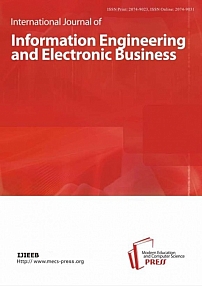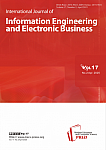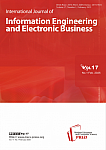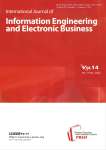International Journal of Information Engineering and Electronic Business @ijieeb
International Journal of Information Engineering and Electronic Business
International Journal of Information Engineering and Electronic Business (IJIEEB) is a peer reviewed journal in the field of Information Engineering and Electronic Business. The journal is published 6 issues per year by the MECS Publisher. All papers will be blind reviewed. Accepted papers will be available on line (free access) and in printed version. No publication fee.
IJIEEB is publishing refereed, high quality original research papers in all areas of Information Engineering and Electronic Business.
IJIEEB has been indexed by several world class databases: Google Scholar, Microsoft Academic Search, CrossRef, DOAJ, IndexCopernicus, INSPEC(IET), EBSCO, VINITI, JournalSeek, ULRICH's Periodicals Directory, WordCat, Scirus, Academic Journals Database, Stanford University Libraries, Cornell University Library, UniSA Library, CNKI Scholar, ProQuest, J-Gate, ZDB, BASE, OhioLINK, iThenticate, Open Access Articles, Open Science Directory, National Science Library of Chinese Academy of Sciences, The HKU Scholars Hub, etc...
The journal publishes original papers in the field of information engineering and electronic business which covers, but not limited to the following scope:
Electronic Business
E-Learning and Mobile learning
Computer Aided Instruction (CAI)
Information Technology in Education
Information Hiding and Digital Watermark
Security and Privacy
Management Information System
Decision Supposed System
E-Business/E-hostpitall/E-Society
Network Engineering
Software Engineering
Wireless/Mobile communication
Artificial Intelligent System
Pattern Recognition
Data Mining and Knowledge Discovery
Distributed/Mobile/Grid/ Ubiquitous Computing
Computer Vision
Rough Set Technology
Robot Technology
Multimedia Technology;
Search Engine Technology
Virtual Reality Technology
Database Technology
Intelligent Transportation Technology
Measurement Technology
Graph and Image Processing
Computer Application Technology
The journal publishes original papers in the field of information engineering and electronic business which covers, but not limited to the following scope:The journal publishes original papers in the field of information engineering and electronic business which covers, but not limited to the following scope:The journal publishes original papers in the field of information engineering and electronic business which covers, but not limited to the following scope:
Modern Education and Computer Science Press
Выпуски журнала
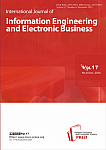
6 vol.17, 2025 International Journal of Information Engineering and Electronic Business
Выпуск журнала
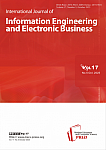
5 vol.17, 2025 International Journal of Information Engineering and Electronic Business
Выпуск журнала
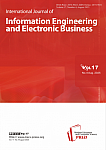
4 vol.17, 2025 International Journal of Information Engineering and Electronic Business
Выпуск журнала
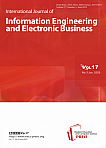
3 vol.17, 2025 International Journal of Information Engineering and Electronic Business
Выпуск журнала
Статьи журнала
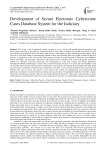
Development of Secure Electronic Cybercrime Cases Database System for the Judiciary
Статья научная
The recent covid-19 pandemic created a barrier to every activity that needed physical interaction and involvement, especially in the judiciary. Careful research of some courts in Nigeria shown that case records are still been manually processed and stored and some courts operate a semi-digital and semi-manual processing pattern, which also has its own shortcoming of preprocessing manual records and converting them into digital records and physical presence is required to access court records. This research develops a secure electronic Cybercrime Cases Database System (eCCDBS), for prosecuted cybercrime in the judicial service in Nigeria. The system will provide an efficient method for collecting, retrieving, preserving, and management of court case records. The Rapid Application Development (RAD) methodology is used for the system development, because of its speed and time friendliness and can be easily restructured to meet the client’s requirement at any point in time during the development life span. RAD can also present a prototype of the final system software to the client. Access control mechanism and secure password hashing were used to ensure the security of the system. The system was implemented and evaluated through deployment and found to have functioned according to the specification. The application subunits of records’ creation, submission, modification, deletion, retrieval, and storage functioned effectively. Hence this system provides a secure online repository specifically for cybercrime case records that have elements of confidentiality, integrity and availability.
Бесплатно
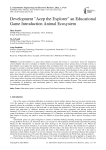
Development "Acep the Explorer" an Educational Game Introduction Animal Ecosystem
Статья научная
Acep the Explorer is a game about animal ecosystem, this lesson is a must-know lesson for elementary school children who aim to introduce to children who are just beginning to know animals that are foreign to them, so that children can recognize the animals and place them according to their own ecology. Educational games are games designed or created to stimulate thought including increasing concentration and problem solving. This game developed by multimedia development system, start form concept, design, until testing. AI development is also carried out in this game, we use a finite state automata to create enemies that annoy players The result of this research, an educational game about animal ecosystem and the children's response to the use of educational games know animals according to ecosystem is good, children can get to know animals according to their ecosystem. And the AI, the Finite state automata in this game makes the game more challenging, interesting and fun. Because in this game they can learn while playing games and face some obstacles and destroy the enemy hunting device and complete the game. This research contributes to combining AI technology with educational games to make students learning about animal ecosystems more interesting and challenging.
Бесплатно
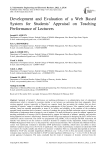
Статья научная
Appraisal of lecturers’ effectiveness on teaching performance is an administrative duty of educational administrators which is intended to ascertain whether or not lecturers are performing their duty adequately. Most existing appraisal systems (especially in Nigeria) are superior based thus preventing the students that are direct recipients of lecturers’ output to evaluate the teaching competencies of their lecturers. Also, appraisal results that are students’ based are reported questionable in terms of its validity and reliability as the outcome of the evaluation reported biased assessment due to lecturers’ coercion of students into giving falsified evaluation reports or intentional falsification of judgements about a lecturer by sets of students. This study developed a system for students’ appraisal on teaching performance of lecturers (SATP) characterised by support for reduction of students’ partiality and prejudice during appraisal on lecturers’ effectiveness. Domain Driven Design was employed in designing the SATP client-server architecture and its framework. The SATP was programmed using HTML, CSS, JavaScript and PHP. Afterwards, 60 students were allowed to use the system to evaluate 6 lecturers in computer science department, Federal College of Wildlife Management which serves as the purposively selected research domain. The evaluation data obtained from the system were statistically evaluated to determine SATP performance (suitability, effectiveness and ability to detect falsified evaluation) using t-test at 0.10 level of significance. The results of performance evaluation revealed that SATP was found to be visually suitable and effective for lecturers’ evaluation. More so, evaluation data reported as not been falsified by SATP also recorded insignificant differences (∆μ = 0.36, p>0.10) in first and second evaluation while evaluation data reported as been falsified by SATP recorded significant differences (∆μ = 12.22, p<0.10) in first and second appraisal (evaluation). The study concluded that the result of evaluation of lecturers retrieved from the developed SATP is valid and recommend the adoption of the system in tertiary institutions as it will improve the excellence of educators and academics in tertiary institutions.
Бесплатно
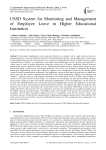
USSD System for Monitoring and Management of Employee Leave in Higher Educational Institution
Статья научная
Unstructured supplementary service data also referred to as feature code or quick code has become a monumental part of services and products offered by Telecommunication Operators, and its application to various areas of telecommunication and real-world scenarios. It is a protocol of communication utilized by global system for mobile communications cell phones to communicate with mobile telecommunication network operators and applicable to various areas of trend in modern information technology sectors such as Wireless Application Protocol browsing, mobile-money services, prepaid call back services, menu-based information services, location-based content services, paid content portal, voting surveys, and product promotion. This system was designed by integrating the designed unstructured supplementary service data channel for employee leave management system into the standard global system for mobile communications architecture. The architecture consists of three parts; the front end, the middle end, and the back end. The system is implemented using PHP for the overall programming, MySQL for the database, and Windows 7 operating system as a development environment with Adobe dream weaver CS3 IDE. Apache TOMCAT webserver was used to host the system locally. Two interfaces were developed; one side with the mobile operators, which requires setting up of SS7 stack and the unstructured supplementary service data application over the stack. On the other side, HTTP-basedAPIs were used for the unstructured supplementary service data application. Several types of leaves exist and their usage depends on educational institution policies. An employee may apply for study leave like maternity leave, sick leave, and annual leave. Paper-based work is time consuming, USSD based activities are very simple and effective. This research work was conducted to solve the leave management in an academic institution using the USSD. Using the developed system, 1326 USSD sessions were recorded, 1238 sessions were successful, 59 were incomplete, and 29 failed. Cumulative findings from the 41 respondents reveal that the system is faster, more convenient, and user-friendly than the manual method of applying and managing employee leave, which indicates 94% of the success of the system. Thus, it can be concluded that the system was able to manage the leave management very well and very effectively.
Бесплатно
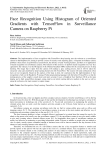
Статья научная
The implementation of face recognition with TensorFlow deep learning uses the webcam as a surveillance camera on the Raspberry Pi, aiming to provide a sense of security to the requiring party. A frequent surveillance camera problem is that crimes are performed at certain hours, the absence of early warning features, and there is no application of facial recognition on surveillance cameras. The function of this system is to perform facial recognition on every face captured by the webcam. Use the Histogram of the Oriented Gradient (HOG) method for the extraction process of deep learning. The image that is input from the camera will undergo a gray scaling process, then it will be taken the extraction value and classified by deep learning framework with TensorFlow. The system will send notifications when faces are not recognized. Based on the analysis of the data is done, the conclusion that the implementation of face recognition is built on the Raspberry Pi using a Python programming language with the help of TensorFlow so that the training process of the sample is much faster and more accurate. It uses a Graphical User Interface (GUI) as the main display and is built using Python designer, using email as an initial warning delivery medium to the user as well as using the webcam as the main camera to capture image.
Бесплатно

